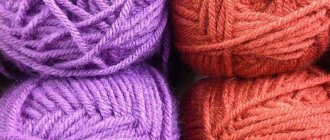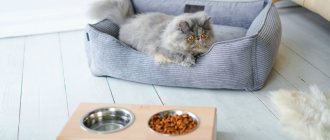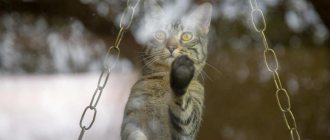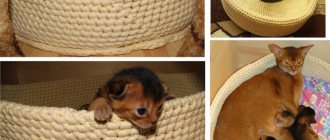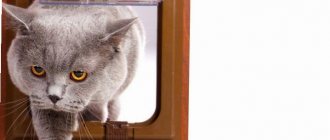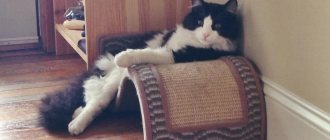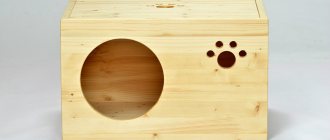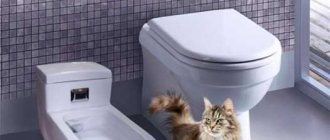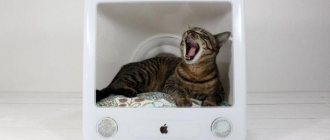Cats are known to be promiscuous. Female cats (queens) often mate with multiple male cats (toms) during the same estrus period. Male cats themselves are determined to spread their genes as much as possible. While they are sexually mature and uncastrated, they are always on the lookout for available females. Due to a lack of selectivity, their offspring sometimes become mating partners.
Cats will mate with their own offspring, although not always. Cats are more likely to mate with distant relatives or relatives one generation apart, such as grandparents and grandchildren. Typically, female cats are much more selective when it comes time to mate. They will try to find other comrades if possible. If this is not possible, they may choose parents or offspring as a last resort.
Not all parent cats will attempt to breed with their offspring, and it is difficult to predict whether they will. Inbreeding does not guarantee genetic diseases, but it does increase the risk. If this happens between close relatives, there is a high probability of transmission of recessive traits. Although hormones greatly influence a cat's actions, certain biological factors inhibit inbreeding. This prevents negative traits from becoming widespread.
The right age for mating
Scottish Folds belong to a group of fairly robust medium-sized cats. Like other animals, they enter sexual maturity at 8-9 months. But by this time, the female’s young body has not yet become stronger and pregnancy during the first or second heat will greatly affect the development of the pet. Therefore, a Scottish cat can be bred for the first time at the age of 1.5 years.
A Scottish Fold cat may be younger than his chosen one, but for the first mating it is still worth choosing a partner with experience. It’s very bad when they both don’t have practical skills and don’t know which way to approach each other. In addition, the cat at the first mating usually begins to scratch, lie on her side and is not able to understand what she needs to do. In this case, you will need the help of an experienced instructor.
Important! If owners do not plan to use the Scottish Fold for breeding, it is recommended to spay or neuter him.
Who can breed a Scottish Fold cat with?
The issue of choosing a mating partner in the Scottish Fold group plays a major role. It's all about complex genetics, which affects the health of the offspring, their immunity and compliance with breed qualities. Breeders have never been able to achieve sustainable results when breeding fold-eared cats.
Small flaws in the breed remain, but negative consequences can only be avoided if Scottish Fold cats are bred according to the rules, even at home.
Fold is caused by the presence of a simple dominant gene FdFd in the genetic map of the animal.
The very first Scottish Fold cat was bred with ordinary cats. As soon as the group expanded and boys with drooping ears appeared, they were also included in the breeding plan.
Due to inbreeding (closely related mating of mother and sons or brothers and sisters), animals developed problems with joints and bones. It was possible to breed Scottish Fold cats with ordinary cats, but in this case the breeders would get both straight-eared and fold-eared children. And the experimenters really wanted all the kittens to be real folds.
All hereditary diseases were then attributed to intrabreed mating, and almost put an end to the future fate of the Scottish Fold. Later, the Americans abandoned the idea of producing 100% of the offspring with the auricle mutation, and began to cross both lines (straight-eared and curved-eared), thereby rehabilitating the unique animals. They developed a strategy, approved standards and launched the mass breeding of Scottish fold cats at home and in nurseries.
Is it possible to bring brothers and sister cats together?
and the meaning. that there are no others... you risk that from close inbreeding sick puppies with physical deformities will be born
Only ABNORMAL OWNERS can do this.... This, first of all, is a very tough experiment with the psyche of dogs (which, unfortunately, is not very stable at present), we can say that 99% of the puppies obtained from such a mating will be INADQUATE dogs
You mean inbreeding, I know that a daughter and a father can happen. But there is at least a little blood diluted there, and I think that my sister and brother are absolutely not. Although we need to consult in some club.
If you want to ruin the pedigree of both dogs and have them sweat
Is it possible to breed dogs if they are brother and sister?
Hello. I have the following question for you: Is it possible to bring dogs together if they are brother and sister? I called our city veterinary clinic and the doctor said that dogs are not people, in general, you can breed them, nothing bad will happen from it. But I still doubt it and so I decided to ask you for advice.
Source
Is it possible to breed relatives' cats?
Inbreeding cats
The fastest practical way to increase homozygosity in higher animals is to mate siblings who have the same father and mother (it makes no difference whether the sibs are taken from littermates or from different litters), as well as to mate father and daughter or mother to son.
It should be noted that the mating of second cousins (common great-grandfather) leads to an increase in homozygosity by only 2% over an infinite number of generations. Consequently, inbreeding of this type is already fundamentally different from closer degrees of inbreeding and essentially does not lead to the achievement of the goals that are placed before the system of consanguineous matings. Breeders who, for one reason or another, avoid inbreeding may not be afraid to mate second cousins.
Practice the goals of inbreeding cats. Let us consider in general and summarize the tasks that are performed and the goals that are pursued by livestock breeders, including cat breeders, when using inbreeding.
Thirdly, the purpose of inbreeding may be to breed a highly potent producer, that is, one that effectively passes on its traits to children. It is known that inbred animals have a higher individual prepotency compared to individuals obtained from unrelated crosses. Because of this, it is a widely accepted practice in animal husbandry to mate an inbred male with a non-inbred female; This practice is called top crossing. It is important that a good inbred producer, passing on his selected qualities to his descendants, can significantly improve the nursery stock and give it its own face, its own peculiarity, its own type.
Source
This article is addressed to those cat lovers and owners of catteries, as well as the chairmen of those clubs and associations whose main goal is to consolidate and improve the pedigree qualities of their animals through purebred breeding and selection (selection). Let us immediately emphasize that since selection involves strict culling, this goal comes into conflict with commercial cat breeding, where the main goal is profit. Inbreeding as a component of purebred breeding. In the course of his work, the breeder must decide which females should be mated with which selected males so that their offspring will combine certain characteristics and acquire improved traits. This selection event is called selection of pairs for crossings. The selection of pairs should be carried out systematically and systematically, and its goal is to change the genetic structure of the animal population of a given nursery in the desired direction or to preserve and consolidate a certain combination of valuable traits in the offspring. Sometimes, to breed new breeds or introduce completely new characteristics into a breed that were not previously characteristic of it, interbreeding or even interspecific crossing is used, but usually the main direction of the breeder’s work is the so-called purebred breeding - mating of individuals of the same breed.
Purebred breeding is divided into two types: outbreeding - a system of unrelated matings of animals within a breed, and inbreeding - a system of matings of individuals having a close degree of relationship, such as brother-sister, father-daughter, mother-son, cousins, etc. . In general, inbreeding assumes that the mated individuals - the future father and mother - have common ancestors or at least one common ancestor. Although for specialists the importance and necessity of inbreeding in purebred breeding is obvious, among amateurs there are a lot of myths and prejudices, both against inbreeding itself and against the use of inbred sires in breeding. (We will say in advance that the latter is a particularly big mistake, since inbred selective sires are, as a rule, prepotent - their children turn out to be mostly like their father - and also often produce exceptionally strong offspring.)
Genetic basis of inbreeding
. What is the biological (genetic) essence of inbreeding? All modern breeds of animals, including cats, are heterozygous for many genes. This means the following. The zygote - a fertilized egg - receives one complete set of genes from both the father and the mother, so that it has a double set of them. If both genes responsible for a given trait - one from the father and the other from the mother - are identical, then this condition is called homozygous for this gene, and an individual homozygous for this gene will develop from the egg. If the genes of the equivalent pair, for example, those determining the formation of black hair pigment, are different (say, the father passed on the black color gene C, and the mother passed on a modified, for example, Himalayan, cs gene), then the individual will turn out to be heterozygous for this gene (Ccs). In the latter case, the black color gene is dominant, and the animal will be externally (phenotypically) black, but will be a carrier of the recessive (hidden) Himalayan gene. If such a heterozygous animal - let it be a black cat, a carrier of the Himalayan gene - is crossed with its sister, also a black cat, carrying a hidden Himalayan gene, then a split will be observed in the offspring (Fig. 1): part of the offspring will be black in color (CC - homozygous , and Cсs are heterozygous genotypes), and the other part is Himalayan (сссs homozygous genotype). This happens because when crossing this black cat with his black sister, their gamete sex cells (sperm and egg) - carrying a single set of genes, will occur in all four possible combinations: C from cat and C from cat, C from cat and cs from cat, cs from cat and C from cat, cs from cat and cs from cat. Therefore, with a probability of 1/4, two Himalayan genes (one from the father, the other from the mother) will converge in one zygote and give a homozygous Himalayan genotype and, therefore, a Himalayan phenotype in some kittens of the litter. The other part of the litter, with the same probability of 1/4, will be homozygous for the solid black gene (CC). Thus, the genetic essence of inbreeding comes down to the process of decomposition of a population into lines with different homozygous genotypes. Since during inbreeding, genes that were in a heterozygous state pass into a homozygous state; in the next generation, when crossing homozygous animals of the same color, no splitting will be observed. In this way, with the help of inbreeding, hidden traits are identified, desired traits are consolidated in generations, and stable genetic lines are created.
The fastest practical way to increase homozygosity in higher animals is to mate siblings who have the same father and mother (it makes no difference whether the sibs are taken from littermates or from different litters), as well as to mate father and daughter or mother to son.
The opinion sometimes expressed among non-professionals that, they say, it is possible to mate a father with a daughter, but not a mother with a son, is a myth that has no basis; the effect of both types of inbreeding is exactly the same. If such close inbreeding (incest) is carried out for 16 generations in a row, then 98% homozygosity is achieved for all genes, and therefore, due to the absence of segregation, all individuals of these litters become almost identical in genotype and phenotype - all children are identical, like twins, Of course , in practice, a much smaller degree of inbreeding is usually used, and accordingly a much lower degree of homozygosity is achieved.
It should be noted that the mating of second cousins (common great-grandfather) leads to an increase in homozygosity by only 2% over an infinite number of generations. Consequently, inbreeding of this type is already fundamentally different from closer degrees of inbreeding and essentially does not lead to the achievement of the goals that are placed before the system of consanguineous matings. Breeders who, for one reason or another, avoid inbreeding may not be afraid to mate second cousins.
Determining the degree of inbreeding and the inbreeding coefficient in cats
. Based on the analysis of the animal's pedigree, it is possible to qualitatively assess the degree of inbreeding, which is expressed by the saturation of the pedigree with common ancestors (nicknames) on the maternal and paternal lines. According to Shaporouge, Roman numerals denote generations (a series of ancestors), counting the parent as the first, grandfather as the second, etc. If a common ancestor is repeated in both the maternal and paternal parts of the pedigree, then its occurrence in the maternal pedigree is indicated first, and then, after a dash, in the paternal pedigree. Then the crossing son x mother will be designated as I-II (Fig. 2, a), father x daughter as II-I (Fig. 2,6), brother x sister as II-II (Fig. 2, c, d) , grandfather x granddaughter as III-I (Fig. 2, e), cousins x sister as IIIIII (Fig. 2, f), etc. Inbreeding type father x daughter (II-I), son x mother ( I-II) and brother x sister (II-II) is designated as very close, or incest; inbreeding type II-III or III-II is close inbreeding; and crossing III-IV, IV-III, IV-IV, II-V, etc., is moderate inbreeding. Due to the lack of perceptible effects, more distant inbreeding may in practice not be considered true inbreeding. Owners of high-quality purebred cats, having picked up the cat's pedigree, can themselves assess how often and to what extent inbreeding was used by the breeders who participated in the breeding of this pet.
To quantitatively take into account the degree of inbreeding in the pedigree of an animal and thereby determine the measure of its homozygosity, the English geneticist S. Wright introduced the concept of inbreeding coefficient (F). This coefficient is calculated as follows. First, the number of generations (arrow - such as in Fig. 2) from the common ancestor A of the father and mother to the father of a given animal (p) is calculated, then the number of generations (arrow) from the same ancestor A to the mother (m). These numbers are summed up, and one is added to the sum: n = p+ m+ 1. The inbreeding coefficient of the analyzed animal (proband X) for this ancestor is equal to 1/2 to the power of n: Ga = (1/2)n. If the father and mother have several common ancestors, then the coefficients are summed up: Fx =EF, =E(1/2)n, where i are the common ancestors of A, B, C, etc.
As an example, let’s calculate the inbreeding coefficient of an animal (proband X) obtained from crossing siblings (II-II, Fig. 2c). In the pedigree, the distance (path) from grandfather to father is 1 generation, from grandfather to mother is 1 generation, therefore, n = 1 + 1 + 1 = 3, which means Fв = (1/2)3 = 1/8. But they have one more common ancestor - their grandmother; from her to her father is 1 generation, from her to her mother is 1 generation, and therefore Fa will also be 1/8. The overall inbreeding coefficient for X is Fx = Fa+ Fb = 1/8+ 1/8 = 1/4, or 0.25.
Another example is the crossing of a grandfather with a granddaughter (III-I, Fig. 2,e). Here the offspring on the paternal line have no generations (arrows), i.e. 0 generations, on the maternal side - 2 generations, whence n = 0 + 2 + 1 = 3, and then Fx = (1/2)3 = 1/8, or 0.125.
Finally, an example with crossing cousins with sister (III-III, Fig. 2, f). The common ancestors of their offspring are their great-grandfather and great-grandmother. From great-grandfather to father - 2 generations, from him to mother 2 generations, i.e. n = 2 + 2 + 1 = 5, and accordingly Fb = (1/2)' 1/32. The same is obtained when calculating the inbreeding coefficient for another common ancestor - great-grandmother: Fa = (1/2)3 = 1/32. Therefore, the total inbreeding coefficient Fx = Fa + Fb = 1/32 + 1/32 = 1/16, or 0.0625.
From available pedigrees, each breeder or owner of a purebred animal can calculate the inbreeding coefficient of their pets or their parents and grandparents - if inbreeding was used in their production. As already mentioned, this coefficient is an indicator of the degree of purity (homozygosity) of the lines participating in the pedigree, as well as an indication of the possible prepotency of the corresponding sires and/or female sires (see below). The higher the inbreeding coefficient of an animal, the more of its genes are in a homozygous state. Naturally, as follows from the formula, the inbreeding coefficient cannot exceed one.
Inbreeding depression and heterosis
. Why is it that in human society, in most civilizations, there is either a direct ban on incest or condemnation of it? Moreover, why in the wild is everything adapted in such a way as to avoid inbreeding and homozygosity as much as possible? The main reason is that both wildlife and human society require a variety of genotypes and individuals in the population to successfully survive and adapt to changing environmental conditions (including social and economic conditions in the case of human society). In a diverse community there will always be individuals best adapted to a given specific situation; however, the situation is changing - and other individuals, with other signs, float to the surface. The uniformity of a population, although well adapted to the given specific conditions of its existence, dooms a biological species to extinction when conditions of existence change. Thus, the desire to create diversity is necessary not for individual individuals, but for the entire species to meet the various and changing demands of the environment and the historical process .
But there is also a direct danger of inbreeding for individual individuals. The fact is that both during the individual life of an animal (and a person), and over generations, mutations—gene changes—occur from time to time. Most mutations are harmful, and if they immediately manifested themselves, they would lead to death (lethal mutations), deformities, abnormal behavior, inconsistencies with the environment, etc. However, most mutations are at the same time recessive in nature, i.e. in combination with a normal paired gene, due to the double set of genes, does not appear in the heterozygous state. The burden of such harmful, but not manifested, hidden mutations is present in every heterozygous individual, including every person. Inbreeding creates homozygosity, including homozygosity for harmful genes, and, consequently, leads to their phenotypic manifestation in the offspring - intrauterine or early death, deformities , reduced viability, etc. This phenomenon is called inbreeding depression.
Let's ask the opposite question: why, despite the danger of inbreeding depression, do breeders who breed and improve domestic animals so often resort to inbreeding and are not afraid of it? The answer is simple: breeders do not strive to ensure maximum survival, vitality and high qualities of all offspring, but select the best, culling (for example, castrating) defective, weak and simply undesirable traits. Thus, during inbreeding, when the genotype is decomposed into homozygous lines, harmful recessive genes appear and are removed from further breeding, and all “good” genes and their combinations are fixed in a homozygous state and left for further generations. Thus, inbreeding in the hands of a breeder is a way of removing the load of harmful mutations from the genotype, on the one hand, and creating the necessary combinations of valuable genes and traits, on the other. In addition, thanks to homozygosity, the homogeneity necessary for breeding any new breed is created, meeting the requirements of this breed, and the corresponding valuable traits are fixed in the offspring. It should be noted that as inbreeding and selection of the best, due to getting rid of the burden of harmful hidden mutations, the danger of inbreeding depression during inbreeding of selected inbred animals decreases.
When crossing between representatives of different independent inbred lines, a phenomenon can be observed that, in a certain sense, is the opposite of inbreeding depression - heterosis, also called “hybrid vigor.” Such hybrids of two inbred animals usually show increased vitality, growth, fertility, etc. This occurs because when crossing between two inbred lines selected and therefore similar in typical characteristics of the breed, homozygosity for these selected characteristics is preserved in the offspring, whereas the remaining harmful mutations that are not rejected are transferred to a heterozygous state and thereby become recessive, i.e. do not appear.
Practice the goals of inbreeding cats. Let us consider in general and summarize the tasks that are performed and the goals that are pursued by livestock breeders, including cat breeders, when using inbreeding.
First, inbreeding is necessary when developing a new breed or a new group within a breed. To increase genetic diversity and attract new traits, the breeder crosses animals of different breeds. The resulting hybrid offspring is heterozygous and will therefore produce segregation in subsequent generations. To consolidate the desired combinations of traits, inbreeding is mainly used close, such as brother x sister, father x daughter and mother x son. As a result of inbreeding, homogeneous families are created and a constant manifestation of traits is achieved. Among inbred offspring, up to 80% of the animals are strictly culled - defective, weak and not meeting the intended standards.
In Fig. Figure 3 shows an example of very close inbreeding when breeding Himalayan cats with lilac markings (lilac point) in the English Mingchew cattery. A cat with a chocolate-point color - Snuff - was obtained by crossing a Tromo cat, with a seal-point color, a carrier of the chocolate and blue genes, from the American nursery Briery, with a Siamese cat Trayvia, also a seal-point and also a carrier of the chocolate and blue genes, from cattery Mingchshch, This chocolate-point cat (Snuff) was bred with her father, the cat Tromo. The cat Chock, a seal-point, born from them was bred with his mother, the cat Snuff, a chocolate-point. From them the first cat with lilac markings (lilac point) was born - Sulatri. It is worth noting the very high inbreeding coefficient of Sulatri: P 3/8, or 0.375, i.e. higher than when crossing siblings.
Secondly, close (very close) inbreeding is used in cases where it is necessary to identify producers who are carriers of lethal, semi-lethal and other undesirable genes. This is the so-called test inbreeding. Based on the results of test inbreeding, various decisions can be made: either such sires are discarded or used to produce homozygous offspring (through inbreeding) with the culling of defective ones and the selection of the best ones, thereby achieving purification of the genotype from unwanted genes.
Thirdly, the purpose of inbreeding may be to breed a highly potent producer, that is, one that effectively passes on its traits to children. It is known that inbred animals have a higher individual prepotency compared to individuals obtained from unrelated crosses. Because of this, it is a widely accepted practice in animal husbandry to mate an inbred male with a non-inbred female; This practice is called top crossing. It is important that a good inbred producer, passing on his selected qualities to his descendants, can significantly improve the nursery stock and give it its own face, its own peculiarity, its own type.
Fourthly, sometimes breeders create inbred lines in their nurseries, so that later, by crossing representatives of different lines (often this is done in cooperation between different nurseries), they can obtain the effect of heterosis - powerful, large, resilient and fertile offspring.
In conclusion, we would like to emphasize that in order to conduct breeding work - including with cats - it is necessary to use systems of competent selection and selection of animals. In this case, selection is distinguished by phenotype and by genotype. Cat lovers are well acquainted with cat shows of various levels, where class assessment (in professional language - grading) of cats is carried out. This is an assessment based on phenotype. Assessment by genotype should be carried out based on the pedigrees of animals and the quality of their offspring. Generally speaking, the breeding value of an animal can be determined only by evaluating the sire by the quality of his offspring. An animal of excellent phenotype will not always be a good producer. Livestock breeders have a catchphrase: “A good bull is worth half a herd.” The same is with stud cats: the quality of the cattery and its personality is largely determined by the stud cat (or stud cats, if there is more than one). Such a stud cat must be highly prepotent, and therefore breeders should turn their attention to inbred studs. Moreover, you cannot create a good nursery by simply purchasing expensive animals with champion and grand champion titles abroad. It is necessary that in the nursery itself and from the nursery producers on the side, animals of the international champion and grand champion level are born. And this requires competent breeding work, in which inbreeding plays a significant role.
Do cats mate with their siblings?
Cat siblings spend a lot of time with each other in their early years as littermates and companions. However, if they are not spayed or neutered before they reach 6 months of age, closely related cats will begin to mate with each other, leading to a number of genetic problems.
Cats don't understand the taboos surrounding incest. Siblings of cats can mate when they reach the reproductive stage. To prevent this from happening, make sure your cats are spayed or neutered before they are 6 months old. Line breeding or inbreeding is not recommended unless you are familiar with your cats' lines.
Why cats mate with their siblings has puzzled owners. But once you understand the psychology behind it, it won't be so difficult. What's complicated is what actually happens when cats mate with siblings.
Do mother cats mate with their offspring?
Once female cats become sexually active, they enter the estrus cycle in order to be receptive to mating. Unlike females, male cats are always ready to mate. Their readiness for this does not depend on hormonal cycles.
Females, as a rule, are more picky in their choice of mates. Therefore, mother cats can mate with their offspring, but it is difficult to say whether the mother will do so. It is not always possible to guarantee that they are attracted to each other, even if they are both sexually mature and intact. However, there are certain factors that increase the chances of this happening. These include:
Parting
According to Scientific American, when animals grow up together, they are less likely to mate with each other. This is true even if they are not closely related.
Growing up together triggers the so-called “kinship radar.” This allows the animal to understand who is related and who is not. If mother and son were separated at an early age, they are much more likely to mate. Their sibling radar does not recognize the other as a sibling.
Older female cats are less picky in choosing a partner. Female cats do not go through menopause and can reproduce as long as they live. Of course, the older a female gets, the less fertile she becomes, and the likelihood of her offspring surviving decreases.
Aging makes a female cat more desperate to mate. She knows her window for successful reproduction is getting shorter. Even if a mother cat ignored her son while she was young, she may change her mind when she gets older.
Mating availability
Cats experience a need to reproduce that is beyond their control. Even if the choice of partners is inadequate, cats will breed with those who are available to them. If the son is the only mature male nearby, the mother is more likely to mate with the son.
Do cats mate with their brothers and sisters?
Cat siblings do indeed mate with each other. Like all mammals, mating is a basic instinct for cats.
When a female cat goes into estrus (heat), the male cat follows his instinct to pass on his genes. A cat's body chemistry will tell her when to mate and when it is the right time for the female to reproduce. Therefore, cats will mate even if they are from the same litter.
However, this does not mean that inbreeding always occurs naturally. The study, published in the journal Brill, examined female control of paternity during copulation. The researchers found that, in general, female cats avoid inbreeding with close relatives during copulation, but not with distant relatives.
When considering feral cats isolated from other colonies, they have no choice but to breed with their siblings and other family members to maintain the colony. However, the report shows that feral cats prefer to seek mates outside their direct bloodline if other cats are available.
Do cats mate with their offspring?
Cats mate with their offspring out of instinct. Both male and female cats reach sexual maturity between 6 and 18 months of age. At this point, a surge of hormones prompts them to pass on their genes. Cats will look for any available pairs to create a new generation.
In some cases, cats cannot find unrelated companions. Then the only option left is with family members. They reproduce easily from parents to offspring, without much hesitation.
However, cats choose more distant relationships if they need to reproduce. If possible, cats will most likely breed between grandparents and grandson or aunt and nephew. Copulation with direct children or siblings is acceptable but not preferred.
However, this is not related to moral principles. While humans consider sexual relations between parents and offspring to be wrong, this is not the case for felines. Cats have no problem mating with their own offspring. As long as they are able to pass on their genes, their mission is accomplished.
If cats hold back at all, it is because of their evolutionary instinct to avoid weak genes. Therefore, male cats most often breed with distant relatives. Breeding too closely means risking the development and transmission of negative recessive traits. Cats, like many other animals, have a natural (if ignorant) instinct to protect their species from this.
Do cats reproduce with their offspring?
According to Kyushu University in Fukuoka, Japan, female cats are less likely to mate with cats that are closely related to them. This instinct is inherent in many living organisms. This is a preventative method used to avoid the negative consequences of incest.
All living organisms with DNA have recessive genes. A recessive gene is a gene that is not inherited by offspring unless both parents have the gene. As an example, we can consider the dilution modifier gene. It dilutes dark colors into lighter ones. Breeders use it to produce various shades of brown and caramel colors in cats.
Even if both parents are not brown themselves, they may have the dilution modifier gene. In this case, their offspring will have brown fur. If only one parent has the gene, the offspring will not have brown fur. However, they will inherit the recessive gene.
Just as there are positive and harmless recessive traits, there are negative and destructive recessive traits. Such negative signs include:
- crooked or small noses
- incorrect position of the jaws
- Low fertility
- Smaller size
- Small limbs
- Flat faces
- Increased risk of cancer
- Joint problems
The smaller the gene pool, the greater the likelihood of parents with recessive genes reproducing. This makes it very dangerous for the next generation as all these signs have serious consequences. They can
- influence the cat's quality of life
- shorten a cat's lifespan
- Reduce the cat's overall chances of survival.
Will a cat mate with her offspring?
Because recessive genes are inherited, closely related families are more likely to have the same recessive genes. After all, they are very similar genetically. Most mutations, especially bad ones, are recessive. Of course, nature tries to avoid inbreeding in animals by ensuring that they are biologically unattractive to their close relatives.
Incest is evolutionarily disadvantageous, so cats reproduce less often with their own offspring than with distant relatives. Negative traits are less likely to be passed on if the partner is not as genetically similar. However, this does not mean that cats cannot mate with their offspring. The likelihood of this cannot be easily determined.
There are some circumstances in which inbreeding is more likely. Overall, it's better to be safe than sorry by spaying and neutering your indoor cats as soon as they reach sexual maturity.
Can sibling cats have kittens?
Kittens can become sexually mature as early as 4 months of age. Female kittens can conceive from around this age, and male kittens can impregnate a fertile female. This can be bad news if you have two cats from the same litter that have not been neutered.
If a female fertilizes a kitten at 4 months of age, there is every chance that the cat will be able to produce offspring at just 6 months of age. This is due to the fact that a cat's gestation period is only 63 days. Experts believe that this is too short a time for a cat to give birth to her first litter.
Cats are also indiscriminate creatures. This means that a brother may mate with a sister because he does not recognize her as family. Most of all, they are like playmates.
To prevent inbreeding, it is best to sterilize the brother cat and sister cat before reaching sexual maturity. Or, if you are looking for a pair of cats to become family pets, you can choose same-sex cats from the same litter. This way you will reduce the risk of siblings mating while still providing them with playmates.
Do father cats mate with their offspring?
Like female cats, male cats can mate with their offspring. However, as with female cats, the likelihood of this happening is difficult to determine. Certain circumstances increase risk. The likelihood of a male cat mating with his offspring is higher if:
he is sexually aggressive
Cats that are sexually aggressive often bully the offspring of both males and females. This does not always lead to reproduction, but it does increase the risk.
Sometimes sexually aggressive cats continue their behavior even after being spayed. Obviously, this specific aggression is usually the result of behavioral problems rather than hormones. You can tell if your cat is sexually aggressive if she barks frequently:
- Inanimate objects
- Animals of other species
Offspring reaches early sexual maturity
When a female cat gives birth, she does not go into estrus until after 12 weeks. Typically, cats begin weaning at this time. However, some mother cats delay their estrus for up to 12 weeks. Female cats can reach sexual maturity as early as 4 months. Therefore, there is a possibility that the father cat will try to mate with the offspring if she goes into estrus earlier than the mother.
The likelihood of inbreeding (due to early maturation) is higher in domestic cats than in feral cats. This is because the father cat is usually the only sexually active male. If the female's siblings have not yet reached sexual maturity due to lack of choice, she will be receptive to the father.
Young offspring
Research has shown that female cats with a shorter estrus period are less selective when choosing mates. This is because their mating window is shorter. Therefore, young cats are more likely to accept their father as a partner.
In young cats, periods of estrus are variable and short. Over time, they level out and lengthen. If the daughter and father are kept separately until the daughter's estrus cycle has stabilized, the likelihood of inbreeding is reduced.
Inbreeding is also less likely if the father is significantly older. Catwomen prefer young cats because youth implies vitality. This is important for the production of healthy kittens.
Is it possible to breed half-breed cats?
Inbreeding between half-siblings is as common, if not more common, than inbreeding between full siblings. In the world of cat breeding, purposefully mating half-siblings is known as "line breeding."
Line breeding involves mating between second-degree relatives (including half-siblings). This process reduces the risk of inherited diseases compared to mating first-degree relatives. However, it does not completely prevent the risk. Any form of inbreeding can cause health problems.
Inbreeding of cats that are not too closely related is preferred by professional breeding organizations to full-blooded mating. As described in the GCCF Breeding Policy, half-sibling breeding produces kittens that match breed integrity, physical and genetic characteristics.
We recommend viewing
Do cats mate with their siblings? Do cats miss their owners when they are returned home? Black Cats
Female cats choose who they mate with. With so many options available, female cats will be most receptive to strong, healthy male cats. One way to identify suitable cats is by the smell of their urine.
When cats have a high-quality protein diet, they produce 2 amino acids that form feline. It is this substance that gives cat urine its pungent odor. The stronger the smell of urine, the more feline it contains. More feline in a cat's urine means she is frequently consuming high-quality protein. This implies that the cat is a good hunter, making him a desirable candidate for females in heat.
Of course, the son can be an indoor cat and have a good diet with plenty of protein. In this case, the mother would theoretically be more likely to mate with him than with any poorly nourished street kitten. However, no formal study has been conducted to determine whether there is a correlation between a male cat's weight and his breeding success.
Domestic cats tend to be overweight and less physically active. Since no research has been done on this issue, it is difficult to say whether a female cat prefers an active, battle-hardened outdoor cat over a well-fed indoor cat. This is true even if the latter has more feline in its urine.
What happens when cats from the same litter mate?
If cats from the same litter mate, there is every chance that their kittens will be born healthy, without obvious genetic problems.
With luck, the litter will have all the desired physical and personality characteristics without any major defects. Inbreeding can be a huge risk, and there is usually no way to know if health problems will arise until the litter is born.
Similar physical traits
Cats born through inbreeding often inherit certain characteristics that are specific to their breed. This may include certain physical traits that are considered attractive.
This could be the size of the paws, the absence or presence of more hair, or the shape of the skull. For cat breeders, this allows them to get better prices when selling cats.
Similar character traits
An inbred cat inherits more than just physical characteristics. It is likely that there will also be character traits. This is why breeders so often mate cats from the same litter - they can shape the temperament with which the litter is born.
Breeding siblings can result in calm temperaments or playful behavior if the parent cats share the same personality traits. The likelihood of this is high since they are relatives. This may be attractive to owners who are looking for a specific type of cat to suit their lifestyle.
Mating with caution
If inbreeding is allowed to occur too often, serious health problems tend to occur every now and then in some of the more thoroughbred cat breeds.
According to the journal Scientific Reports, 64.9% of Persian cats studied had at least one disease. Since Persians are one of the most inbred breeds, this high statistic makes you wonder, “Is it safe to mate cats from the same litter?”
Symptoms of inbreeding in cats
Inbreeding occurs when closely related cats mate. This includes brother and sister, father and daughter, mother and son, and half-siblings.
Cat breeders often use inbreeding to predict what their kittens, especially purebred ones, will look like. Inbreeding helps breeders keep track of their cats' prestigious bloodlines while correcting their bad traits. They may also promise certain characteristics to buyers who are looking for something specific in a cat.
However, inbreeding is not without problems. Not only is this considered ethically and morally wrong, but cats born from inbreeding can develop a variety of health problems.
Genetic defects
Inbreeding increases the risk of genetic defects. Although they are more common in purebred cats, all inbred cats are vulnerable. Hereditary diseases occur due to abnormal genes that are passed on from generation to generation. These may be obvious at birth, while others may not appear until later in life.
The limited gene pool caused by constant inbreeding means that harmful genes become widespread, causing disease and weakness in the breed.
As a natural by-product, buyers are generally reluctant to purchase a cat with obvious health problems that would make the animal unsellable. Breeders often decide to euthanize an animal because it does not meet the requirements.
Overbreeding
Cats that breed regularly with cats from the same bloodline eventually begin to produce litters with more dangerous health problems.
Classic symptoms of overbreeding include small litters of only 1-2 kittens. These kittens may be born with a number of abnormalities, including an improperly positioned jaw, crooked nose, bulging eyes, and dental and oral defects.
Other adverse problems may also arise. These include low fertility in females, immunodeficiency leading to high mortality, and cancers in newborn cats.
Maintaining the purity of the breed
A less alarming result of inbreeding is the possibility of achieving breed purity through line breeding.
Mating cats that have a less direct bloodline - such as first cousins or half-siblings - will help maintain the viability of the breed and reduce the rate of genetic decline. The benefit for the breeder is that he can predict the characteristics and appearance of the litter before the kittens are born.
If you intentionally breed siblings or cats from the same litter, do so with caution. Inbreeding is never a guaranteed process.
Source
